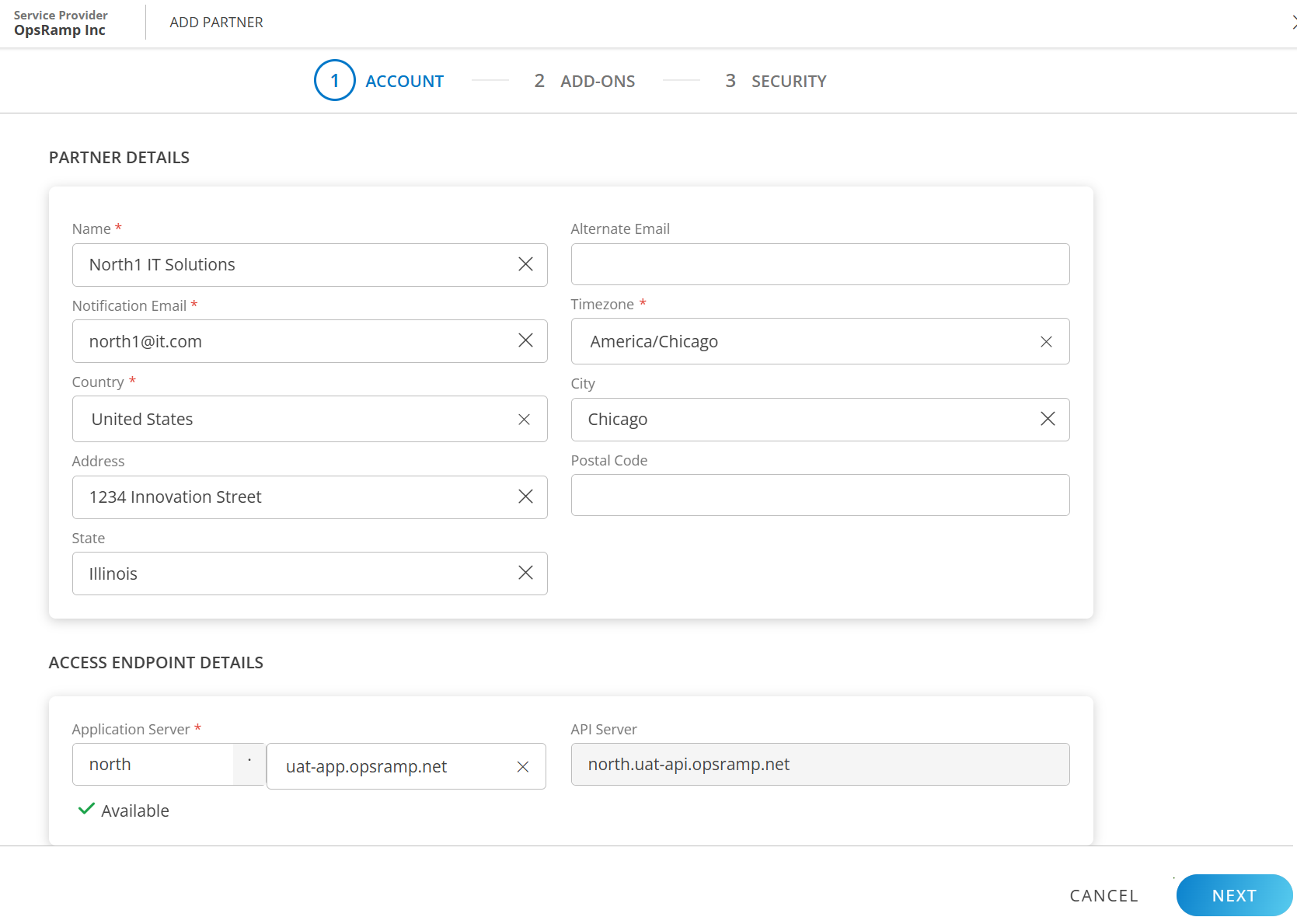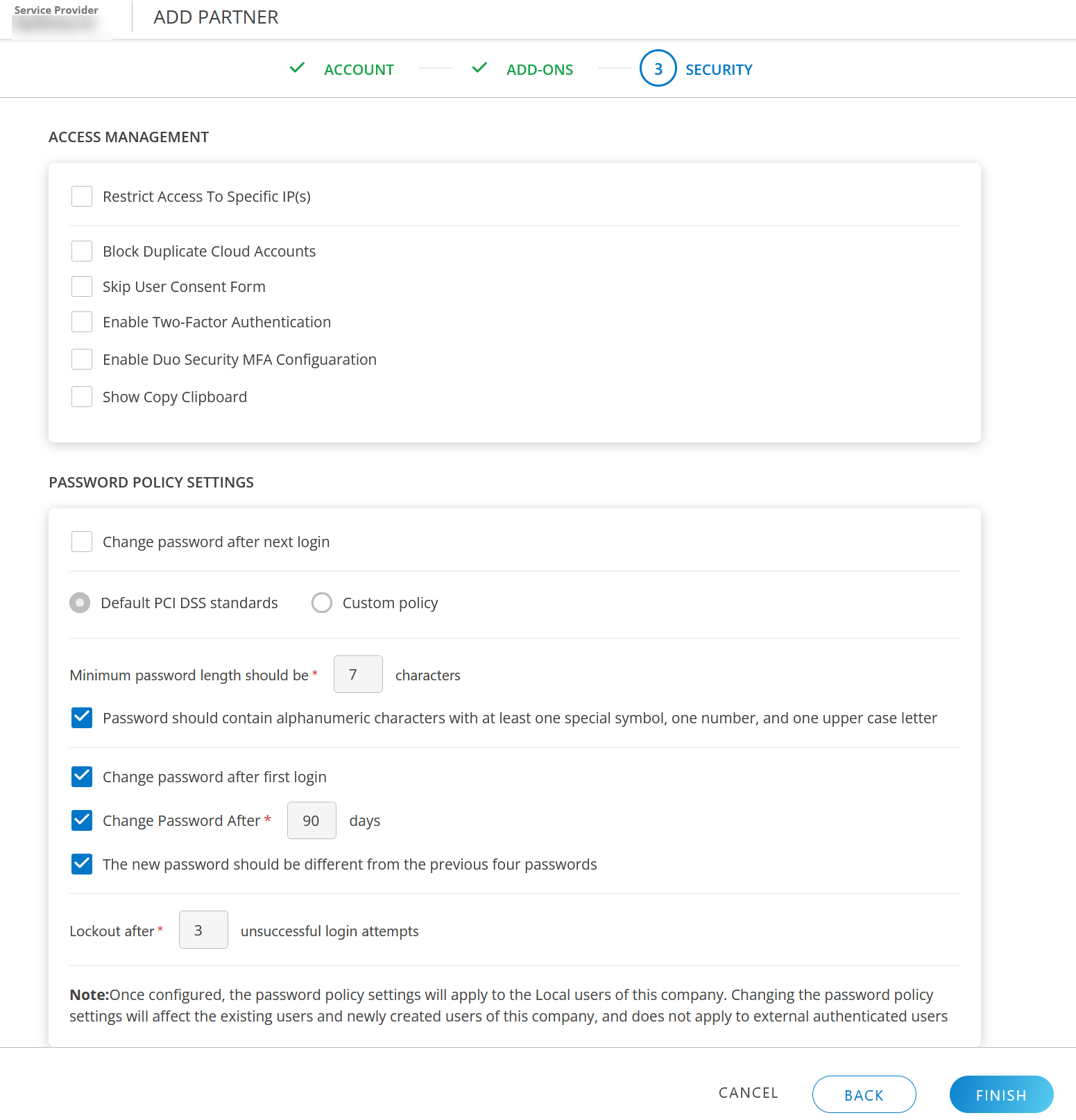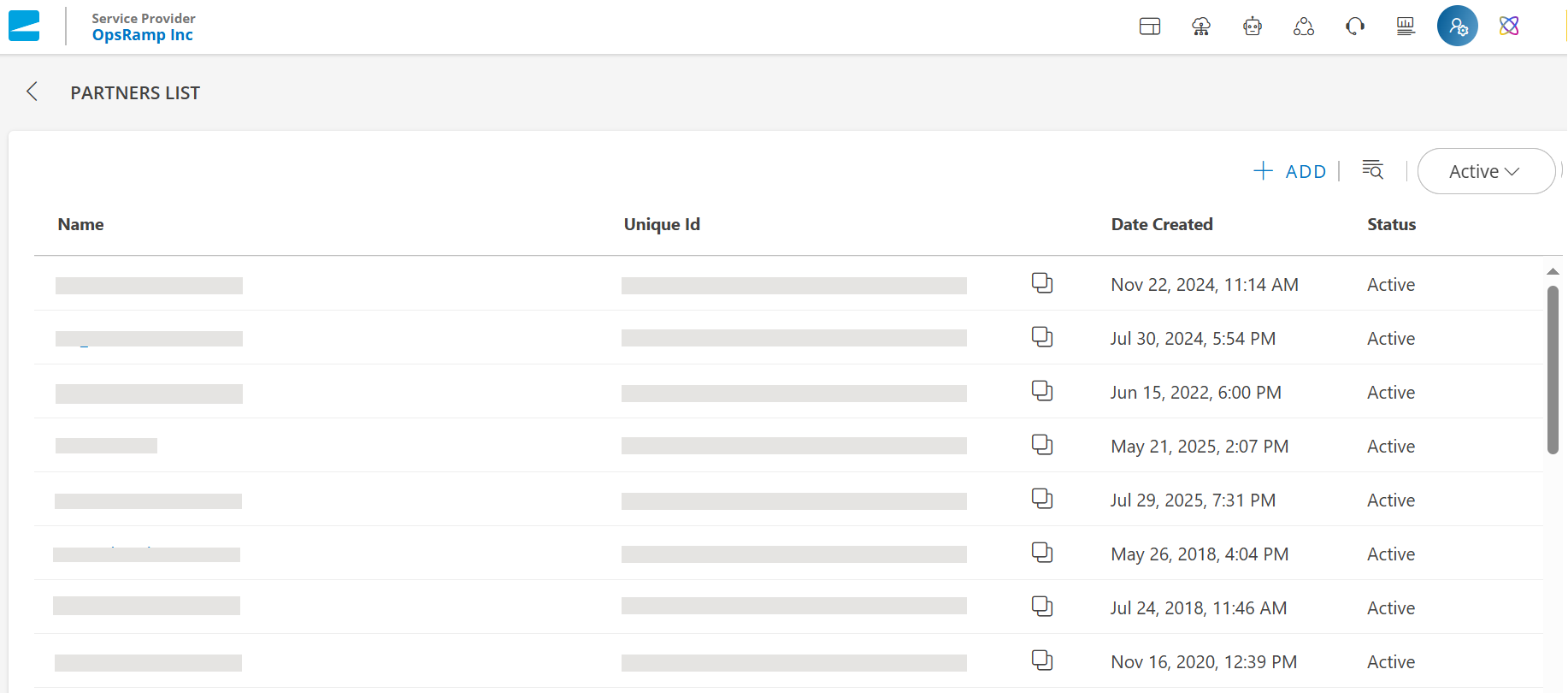Introduction
Creating a partner helps streamline service delivery, especially when working with resellers, regional Managed Service Provider (MSPs), or business affiliates who need autonomy to manage their own clients. It reduces administrative overhead for the service provider and improves scalability by allowing each partner to onboard and support customers independently.
This setup not only ensures operational clarity but also strengthens data security and accountability across the service delivery chain.
Create a Partner
The following video guides you through the process of creating a Partner in OpsRamp.
Navigate through the tabs below and provide the information in each section to complete the partner setup.
ACCOUNT
The Account section has critical information and settings about your partner. It allows you to manage personal information like Name, Notification Email, Country, Timezone, City, State, Access Endpoint Details, and other relevant information.
Click Setup > Account. The ACCOUNT DETAILS screen is displayed.
Click Partners tile. The PARTNERS LIST screen is displayed, showing the list of partners.
Click +ADD. The ADD PARTNER screen is displayed.

Enter the following information.

PARTNER DETAILSField Name Field Type Description Name String Name of the partner. Alternate Email String Alternate Email address of the partner. Notification Email String Partner Email address. Timezone Dropdown Timezone of the partner. Country Dropdown Country where the partner is located. City String City of the partner. Address String Address of the partner. Postal Code Integer Postal code State String State in which the partner is located. ACCESS ENDPOINT DETAILS: The Access Endpoint is the unique login URL that your Partner will use to access their OpsRamp environment.
Field Name Field Type Description Application Server String Hostname or URL of the application server. API Server String Based on the hostname entered in Application Server field, the API Server URL is displayed. This is a read-only field. Click NEXT.
ADD-ONS
The Add-Ons tab allows you to select packages and add-ons, for advancing monitoring, as per partner’s specific operational requirements.
Select one or more of the following packages as per the operational requirement to monitor the infrastructure:
- Hybrid Discovery and Monitoring (default)
- Event and Incident Management
- Remediation and Automation

- Choose the packages that match the requirements.
Based on the packages you select, the Add-Ons are displayed. If you keep only Hybrid Discovery and Monitoring, Adapter Integrations, Extended Data Retention, Mask Resource Identity Management, Offline Alerts, Log Management, and Trace Management are added as Add-Ons.
Hybrid Discovery and Monitoring package
A broad range of IT resources across data center, public cloud, and cloud native environments can be discovered and monitored with agent-based and agentless monitors. These include:
- Data center applications, URLs, containers, servers, and network resources.
- Public cloud environments of compute instances, databases, load balancers, and PaaS services.
- Cloud native environments with containers and orchestrators.
Built-in monitors are provided that capture availability and performance metrics and observer optimal threshold limits for supported resources. You can extend the platform to monitor any kind of IT resource by writing custom monitor scripts.
The Hybrid Discovery and Monitoring package includes the following modules:
- Resource Management
- Monitoring
- Reports
- Dashboards
- Alerting & Forwarding
- Anomaly Detection and Metric Forecasting
Event and Incident Management package
The Event and Incident Management package leverages proprietary event correlation algorithms, incident creation, and machine learning-powered alerts. The package includes:
- Service Desk
- Alert Correlation
- First Response Policies
- Alert Escalation
- OpsQ Machine Learning Bot
Remediation and Automation package
The Remediation and automation package implements patch job scheduling, remediation task execution, and resource maintenance using a remote console. The package includes:
- Patch Management
- Run Book Automation
- Job Automation
- Process Automation
- Remote Access with Session Replay
Add-ons
Following are the Add-Ons for Hybrid Discovery and Monitoring package:

Adapter Integrations – This add-on is used to enable Adapter category Apps, to perform discovery and monitoring of the end device.
Refer Compute, Network, Storage sections under Integrations
Batch Exports - Batch exports allows you to efficiently extract platform-generated enterprise data for data collection and analysis. You can snapshot and batch export the following types of data for each partner on demand and at scheduled intervals to Amazon AWS S3 and Microsoft Azure Blob Storage:
- Ticket data
- Alert data
- Metric data
- Inventory data
- Usage data
See Setup Batch Export for more information.
Extended Data Retention - You can retain the asset data for 12 months.
Offline Alerts - If any resource goes to an unknown state, an alert will be triggered.
Stream Exports - Get event data to the target location without scheduling the data export. The Streaming Export feature streaming of live data to different third-party tools using AWS EventBridge and Webhook.
See Install a Streaming Export integration for more information.
Mask Resource Identity Management - Mask the text of captured sensitive information, including MAC addresses, IP addresses, and host names.
Event and Incident Management
Events represent business-impacting issues that require a response. Event and incident management uses escalation policies to aggregate, interpret, and act on events detected by monitors, resource diagnostics, and third-party integrations.
Using service maps, you can visualize the relationship between monitored resources and assess business and user impact based on resource health.
Event interpretation and response can be automated. Automation correlates and suppresses alerts, notifies users, and creates incident tickets for alerts that need operator intervention.
Add-ons
Following are the Add-Ons for Event and Incident Management package:

Alert problem area – Alert Problem Area enriches the alert Problem Area field with information extracted from the alert subject or description. Alert Problem Area is usually used for log-type alerts where rich information is embedded in the alert subject or description, but the metric value is the generic metric name. If the Problem Area field is not enriched, it defaults to the alert Metric field value.
See Alert Problem Area for more information.
Knowledge Base Management - Capture product information, operational procedures, and frequently asked questions, providing a reference source for the organization.
See Knowledge Base for more information.
OS Service Start/Stop Actions - This add-on provides the ability to start and stop the OS services on agent-installed devices when required permissions are given.
Navigation: Infrastructure > Resources Details > Services.Scheduled Task Management - The Scheduled Task entity provides the ability to schedule and run recurring tasks for a predefined duration and at a specified time period. Each instance of a scheduled task is recorded and grouped as Tasks in the Scheduled Task listing.
See Configure scheduled tasks for more information.
SLA Management - This module, when enabled, helps you to configure the response SLA and resolution SLA for a ticket, based on priority. An SLA (Service Level Agreement) is a negotiated and agreed contract between requester and assignee to resolve entities. SLA quantifies acceptable service levels and outlines when the services are delivered.
See Configure SLA settings for more information.
SMS and Voice - This is a paid add-on, and when enabled will send notifications through SMS and Voice.
Remediation and Automation
Automate operational tasks that respond to events or execute routine maintenance activities. Automation workflow capabilities permit you to compose workflows that are tailor made for your use cases.
Event remediation and automation can be automated by composing workflows to handle events. This includes SMS, Voice, and Email notifications. Remote SSH is also supported for alert resolution.
Add-ons
Following are the Add-Ons for Remediation and Automation package:

Process Automation - This add-on provides the ability to define and execute process automation tasks.
See Process Definition for more information.
Remote Access Management - This is used to enable remote access (RDP, SSH, Telnet) to managed devices.
See Remote Consoles for more information.
Contact Support to change the add-on permission.
Remediation and automation package
The following are unavailable if you opt not to subscribe to this package:
Application Patch Management add-on
Automation option in the Workspace drop-down menu
These permission sets:
- Jobs
- Consoles
- Patch Approvals
- Recording Audits
- Scripts
- Commands
Selecting a partner that is not subscribed to the Remediation and Automation package generates the following warning on the Alerts, Service Desk, and Automation screens:
Access Denied! The partner is not subscribed to this product package.
Event and Incident Management package:
The following are unavailable if you opt not to subscribe to this package:
Event Enrichment, Scheduled Task, SLA, and SMS & Voice add-ons
The Alerts menu option in Setup (Setup > Alerts)
These permission sets:
- OpsQ
- Incident
- Change Request
- Task Request
- Service Request
- Problem
- Time-bound request
Selecting a partner that is not subscribed to the Event and Incident Management package generates the following warning on the Alerts, Service Desk, and Automation screens:
Access Denied! The partner is not subscribed to this product package.
- Click NEXT.
SECURITY
Security feature ensures effective Access Management and stringent Password Policy Settings. Access Management allows you to restrict specific IP addresses, implement two-factor authentication for improved security. Password Policy Settings enables you to implement strict password settings thereby preventing unauthorized access and security breaches.
ACCESS MANAGEMENT
Access Management in OpsRamp includes features such as enhanced security with Two-Factor Authentication and Duo Security MFA Configuration, restricting access to specific IP addresses, and enabling the Show Copy Clipboard functionality thereby enhancing usability.
Select one or more of these options as per the requirements:
Restrict Access to Specific IP(s): Restricting access to specific IP addresses can reduce security issues. Enter the IP Addresses separated by comma.
The following error message is displayed when you attempt to log into the platform from an IP address other than those permitted:Your organization policies restrict you from accessing OpsRamp from your current IP.Block Duplicate Cloud Accounts - Ensure that each cloud account is uniquely created and managed. This helps you to block creation of duplicate resources across partners and reduce unnecessary CloudWatch expenses.
Skip User Consent Form: Select checkbox to skip user consent form. The form popup appears.
- Click ACCEPT to skip the user consent form.
- Click DENY to allow user consent form.
Enable Two-Factor Authentication: Select the checkbox to enable two-factor authentication. See Two-Factor Authentication for more details.
Enable Duo Security MFA Configuration: Select the checkbox to enable Duo Security.
- Enter the Integration Key, Secret Key, API hostname in the DUO SECURITY MFA CONFIGURATION dialog box and click SAVE. The details are displayed.
- Enter the Integration Key, Secret Key, API hostname in the DUO SECURITY MFA CONFIGURATION dialog box and click SAVE. The details are displayed.
Show Copy Clipboard: Select the checkbox to enable Show Copy Clipboard.
PASSWORD POLICY SETTINGS
The Password Policy Settings section allows you to configure password policy, which once configured will apply to all the users of the partner’s clients.
Change password after next login: Select this option, if you want to change password after next login. This means that all the users of the organization will mandatorily have to change their passwords after they login for the first time. This change will make all login sessions inactive.
Note: It is recommended not to change the password policy frequently, as this will affect the existing and newly created users of your organization, and will not apply to external authenticated users.
You can opt for Default PCI DSS standards or Custom policy.
Default PCI DSS standards: Select this checkbox to apply default PCI DSS standards. You cannot modify the settings.
Custom policy: Select this checkbox and configure the policy settings as per your organizational needs.
- Click FINISH. The partner is successfully created and a confirmation message appears.
The partner details are displayed in the PARTNERS LIST screen in a tabular form.

Table below shows the columns with their description:
| Field Name | Description |
|---|---|
| Name | Name of the partner. |
| Unique Id | Unique Id of the partner. |
| Date Created | The date on which the partner was created. |
| Status | The current status of the partner. |
Filter
Use the filter dropdown to view partners that are in Active, Inactive, and All Status (active and inactive) statuses:
- Click Active dropdown and select the following options:
- Active - Displays a list of active partners.
- Inactive - Displays a list of terminated partners.
- All Status - Displays a list of active and terminated partners.
Related Topics
- See View and edit partner details to learn how to view and update a partner’s configuration.